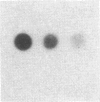Abstract
MCF7 human breast cancer cells selected for resistance to doxorubicin (adriamycin; DoxR) have developed the phenotype of multidrug resistance. Multidrug resistance in DoxR MCF7 cells (called AdrR MCF7 cell line in previous publications) is associated with biochemical changes similar to those induced by carcinogens in rat hyperplastic liver nodules (HNs) and associated with resistance to xenobiotics in that system. In HNs and DoxR cells, exposure to a single agent results in the selection of cells that are cross-resistant to a wide variety of structurally dissimilar toxic agents. Resistance in both systems is associated with decreases in intracellular accumulation of toxins and changes in phase I (decreased cytochrome P1-450) and phase II (increased glutathione transferase and glucuronyltransferase) drug-metabolizing activities. In HNs and DoxR cells, resistance is associated with the induction of relatively stable levels of an immunologically related anionic glutathione transferase isozyme (EC 2.5.1.18). The finding of similar biochemical changes associated with the development of resistance to various xenobiotics in HNs and to many naturally occurring antineoplastic agents and at least one carcinogen (benzo[a]pyrene) in DoxR MCF7 cells suggests that the mechanisms of resistance in these two models may be similar.
Full text
PDF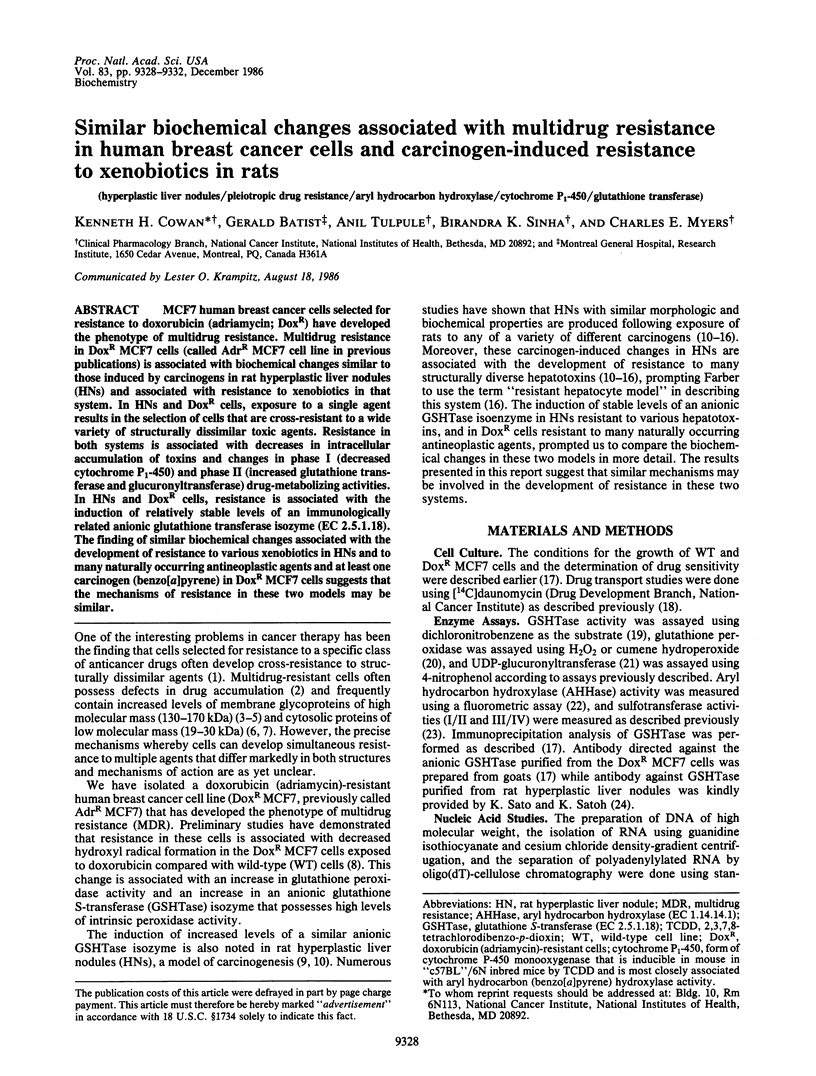
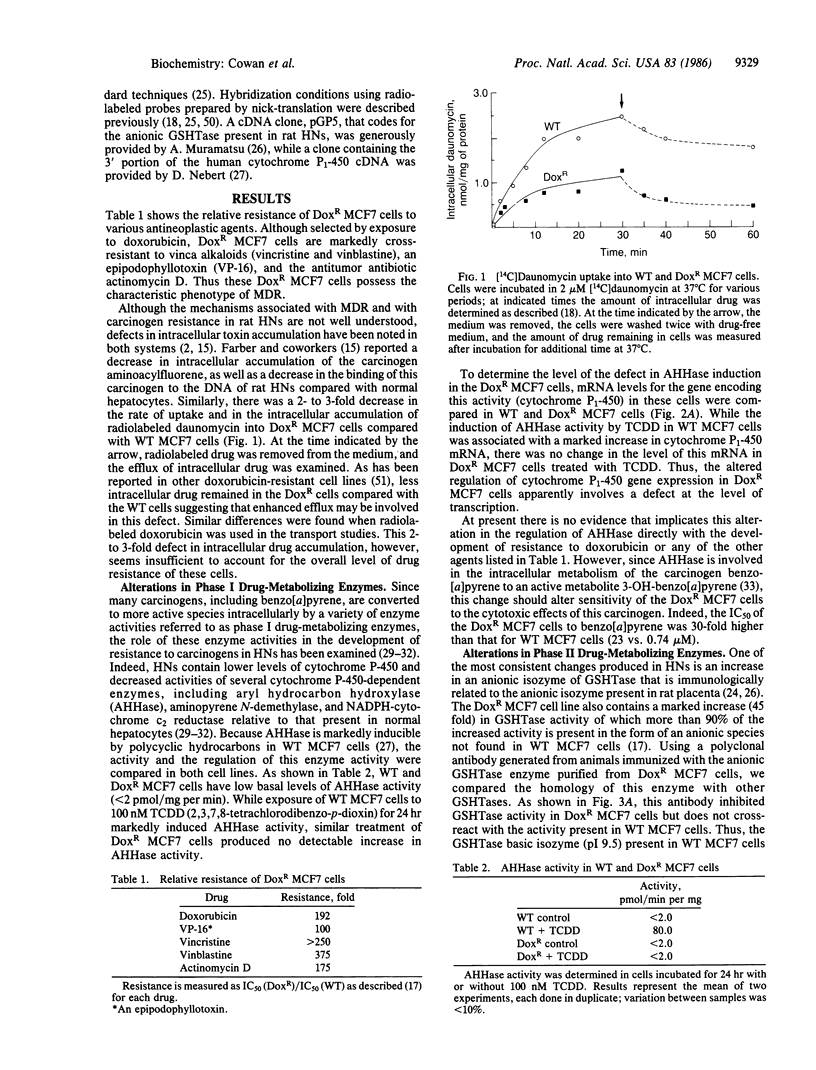
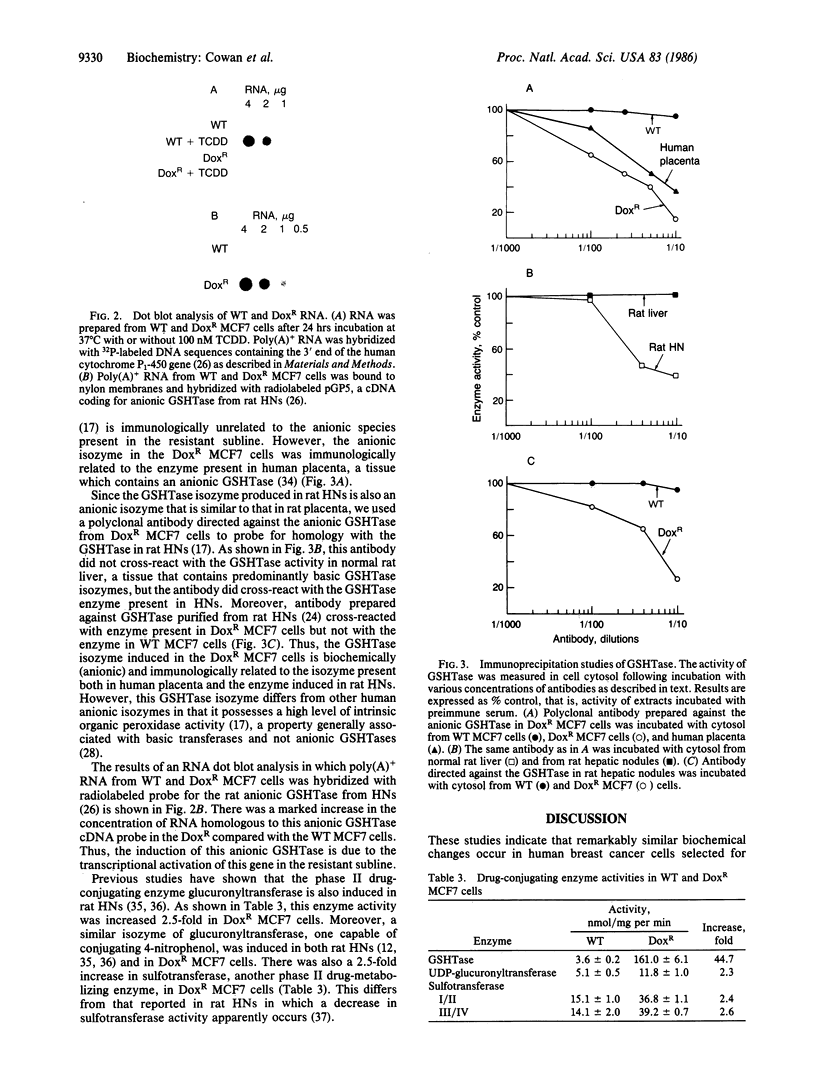
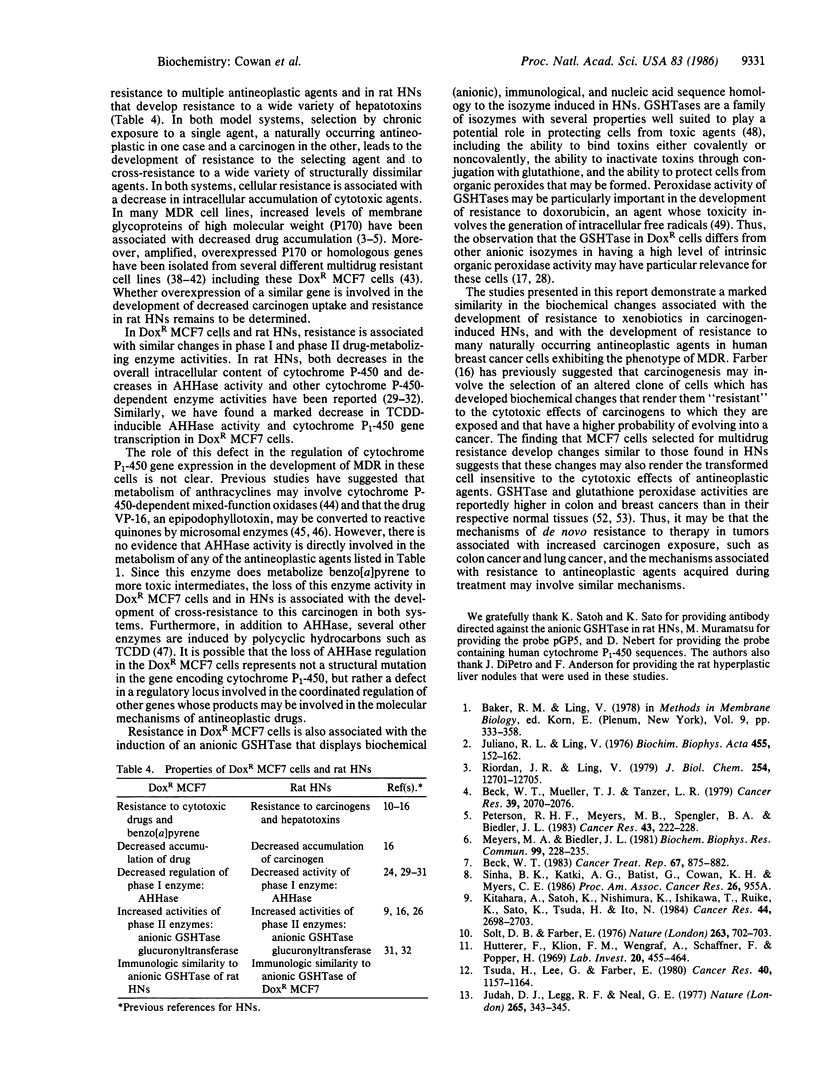
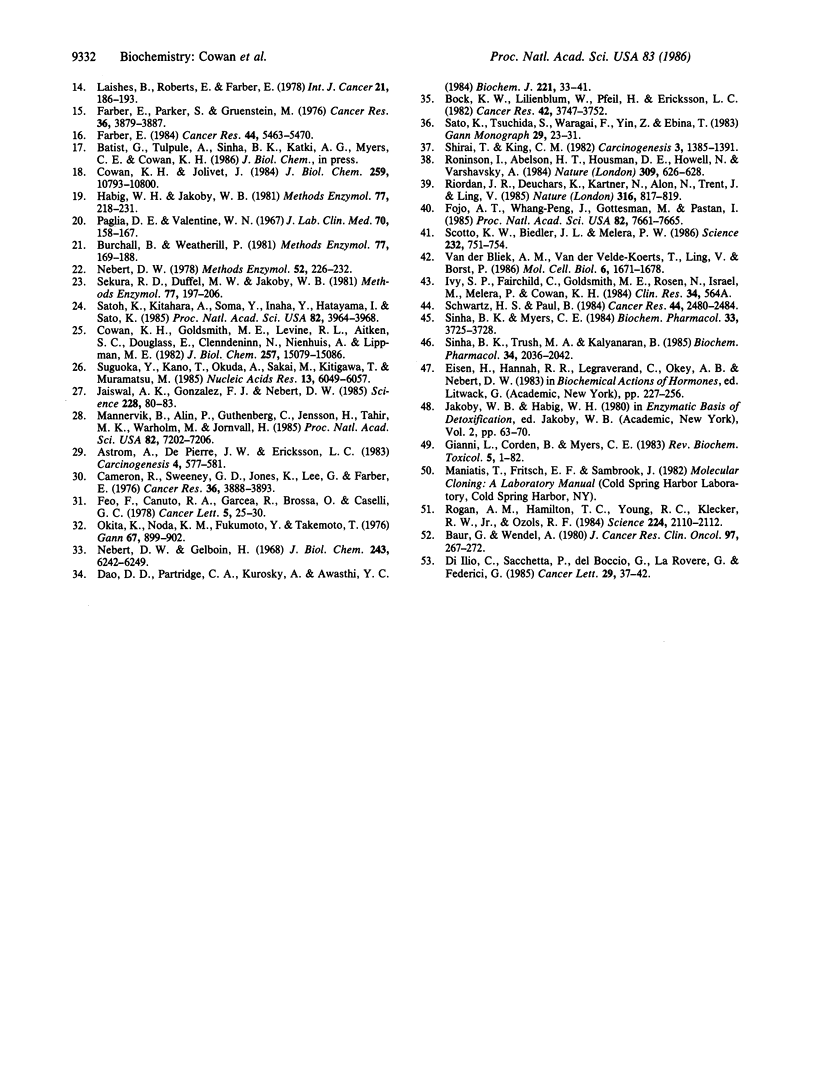
Images in this article
Selected References
These references are in PubMed. This may not be the complete list of references from this article.
- Aström A., DePierre J. W., Eriksson L. Characterization of drug-metabolizing systems in hyperplastic nodules from the livers of rats receiving 2-acetylaminofluorene in their diet. Carcinogenesis. 1983;4(5):577–581. doi: 10.1093/carcin/4.5.577. [DOI] [PubMed] [Google Scholar]
- Baur G., Wendel A. The activity of the peroxide-metabolizing system in human colon carcinoma. J Cancer Res Clin Oncol. 1980;97(3):267–273. doi: 10.1007/BF00405778. [DOI] [PubMed] [Google Scholar]
- Beck W. T., Mueller T. J., Tanzer L. R. Altered surface membrane glycoproteins in Vinca alkaloid-resistant human leukemic lymphoblasts. Cancer Res. 1979 Jun;39(6 Pt 1):2070–2076. [PubMed] [Google Scholar]
- Beck W. T. Vinca alkaloid-resistant phenotype in cultured human leukemic lymphoblasts. Cancer Treat Rep. 1983 Oct;67(10):875–882. [PubMed] [Google Scholar]
- Bock K. W., Lilienblum W., Pfeil H., Eriksson L. C. Increased uridine diphosphate-glucuronyltransferase activity in preneoplastic liver nodules and Morris hepatomas. Cancer Res. 1982 Sep;42(9):3747–3752. [PubMed] [Google Scholar]
- Burchell B., Weatherill P. 4-Nitrophenol UDPglucuronyltransferase (rat liver). Methods Enzymol. 1981;77:169–177. doi: 10.1016/s0076-6879(81)77022-8. [DOI] [PubMed] [Google Scholar]
- Cameron R., Sweeney G. D., Jones K., Lee G., Farber E. A relative deficiency of cytochrome P-450 and aryl hydrocarbon [benzo(a)pyrene] hydroxylase in hyperplastic nodules induced by 2-acetylaminofluorene in rat liver. Cancer Res. 1976 Nov;36(11 Pt 1):3888–3893. [PubMed] [Google Scholar]
- Cowan K. H., Goldsmith M. E., Levine R. M., Aitken S. C., Douglass E., Clendeninn N., Nienhuis A. W., Lippman M. E. Dihydrofolate reductase gene amplification and possible rearrangement in estrogen-responsive methotrexate-resistant human breast cancer cells. J Biol Chem. 1982 Dec 25;257(24):15079–15086. [PubMed] [Google Scholar]
- Cowan K. H., Jolivet J. A methotrexate-resistant human breast cancer cell line with multiple defects, including diminished formation of methotrexate polyglutamates. J Biol Chem. 1984 Sep 10;259(17):10793–10800. [PubMed] [Google Scholar]
- Dao D. D., Partridge C. A., Kurosky A., Awasthi Y. C. Human glutathione S-transferases. Characterization of the anionic forms from lung and placenta. Biochem J. 1984 Jul 1;221(1):33–41. doi: 10.1042/bj2210033. [DOI] [PMC free article] [PubMed] [Google Scholar]
- Farber E. Cellular biochemistry of the stepwise development of cancer with chemicals: G. H. A. Clowes memorial lecture. Cancer Res. 1984 Dec;44(12 Pt 1):5463–5474. [PubMed] [Google Scholar]
- Farber E., Parker S., Gruenstein M. The resistance of putative premalignant liver cell populations, hyperplastic nodules, to the acute cytotoxic effects of some hepatocarcinogens. Cancer Res. 1976 Nov;36(11 Pt 1):3879–3887. [PubMed] [Google Scholar]
- Feo F., Canuto R. A., Garcea R., Brossa O., Caselli G. C. Phenobarbital stimulation of cytochrome P-450 and aminopyrine N-demethylase in hyperplastic liver nodules during LD-ethionine carcinogenesis. Cancer Lett. 1978 Jul;5(1):25–30. doi: 10.1016/s0304-3835(78)80006-8. [DOI] [PubMed] [Google Scholar]
- Fojo A. T., Whang-Peng J., Gottesman M. M., Pastan I. Amplification of DNA sequences in human multidrug-resistant KB carcinoma cells. Proc Natl Acad Sci U S A. 1985 Nov;82(22):7661–7665. doi: 10.1073/pnas.82.22.7661. [DOI] [PMC free article] [PubMed] [Google Scholar]
- Habig W. H., Jakoby W. B. Glutathione S-transferases (rat and human). Methods Enzymol. 1981;77:218–231. doi: 10.1016/s0076-6879(81)77029-0. [DOI] [PubMed] [Google Scholar]
- Hutterer F., Klion F. M., Wengraf A., Schaffner F., Popper H. Hepatocellular adaptation and injury. Structural and biochemical changes following dieldrin and methyl butter yellow. Lab Invest. 1969 May;20(5):455–464. [PubMed] [Google Scholar]
- Jaiswal A. K., Gonzalez F. J., Nebert D. W. Human dioxin-inducible cytochrome P1-450: complementary DNA and amino acid sequence. Science. 1985 Apr 5;228(4695):80–83. doi: 10.1126/science.3838385. [DOI] [PubMed] [Google Scholar]
- Judah D. J., Legg R. F., Neal G. E. Development of resistance to cytotoxicity during aflatoxin carcinogenesis. Nature. 1977 Jan 27;265(5592):343–345. doi: 10.1038/265343b0. [DOI] [PubMed] [Google Scholar]
- Juliano R. L., Ling V. A surface glycoprotein modulating drug permeability in Chinese hamster ovary cell mutants. Biochim Biophys Acta. 1976 Nov 11;455(1):152–162. doi: 10.1016/0005-2736(76)90160-7. [DOI] [PubMed] [Google Scholar]
- Kitahara A., Satoh K., Nishimura K., Ishikawa T., Ruike K., Sato K., Tsuda H., Ito N. Changes in molecular forms of rat hepatic glutathione S-transferase during chemical hepatocarcinogenesis. Cancer Res. 1984 Jun;44(6):2698–2703. [PubMed] [Google Scholar]
- Laishes B. A., Roberts E., Farber E. In vitro measurement of carcinogen-resistant liver cells during hepatocarcinogenesis. Int J Cancer. 1978 Feb 15;21(2):186–193. doi: 10.1002/ijc.2910210210. [DOI] [PubMed] [Google Scholar]
- Mannervik B., Alin P., Guthenberg C., Jensson H., Tahir M. K., Warholm M., Jörnvall H. Identification of three classes of cytosolic glutathione transferase common to several mammalian species: correlation between structural data and enzymatic properties. Proc Natl Acad Sci U S A. 1985 Nov;82(21):7202–7206. doi: 10.1073/pnas.82.21.7202. [DOI] [PMC free article] [PubMed] [Google Scholar]
- Meyers M. B., Biedler J. L. Increased synthesis of a low molecular weight protein in vincristine-resistant cells. Biochem Biophys Res Commun. 1981 Mar 16;99(1):228–235. doi: 10.1016/0006-291x(81)91736-8. [DOI] [PubMed] [Google Scholar]
- Nebert D. W., Gelboin H. V. Substrate-inducible microsomal aryl hydroxylase in mammalian cell culture. I. Assay and properties of induced enzyme. J Biol Chem. 1968 Dec 10;243(23):6242–6249. [PubMed] [Google Scholar]
- Nebert D. W. Genetic differences in microsomal electron transport: the Ah locus. Methods Enzymol. 1978;52:226–240. doi: 10.1016/s0076-6879(78)52026-0. [DOI] [PubMed] [Google Scholar]
- Okita K., Noda K., Fukumoto Y., Takemoto T. Cytochrome P-450 in hyperplastic liver nodules during hepatocarcinogenesis with N-2-fluorenylacetamide in rats. Gan. 1976 Dec;67(6):899–902. [PubMed] [Google Scholar]
- Paglia D. E., Valentine W. N. Studies on the quantitative and qualitative characterization of erythrocyte glutathione peroxidase. J Lab Clin Med. 1967 Jul;70(1):158–169. [PubMed] [Google Scholar]
- Peterson R. H., Meyers M. B., Spengler B. A., Biedler J. L. Alteration of plasma membrane glycopeptides and gangliosides of Chinese hamster cells accompanying development of resistance to daunorubicin and vincristine. Cancer Res. 1983 Jan;43(1):222–228. [PubMed] [Google Scholar]
- Riordan J. R., Deuchars K., Kartner N., Alon N., Trent J., Ling V. Amplification of P-glycoprotein genes in multidrug-resistant mammalian cell lines. 1985 Aug 29-Sep 4Nature. 316(6031):817–819. doi: 10.1038/316817a0. [DOI] [PubMed] [Google Scholar]
- Riordan J. R., Ling V. Purification of P-glycoprotein from plasma membrane vesicles of Chinese hamster ovary cell mutants with reduced colchicine permeability. J Biol Chem. 1979 Dec 25;254(24):12701–12705. [PubMed] [Google Scholar]
- Roninson I. B., Abelson H. T., Housman D. E., Howell N., Varshavsky A. Amplification of specific DNA sequences correlates with multi-drug resistance in Chinese hamster cells. Nature. 1984 Jun 14;309(5969):626–628. doi: 10.1038/309626a0. [DOI] [PubMed] [Google Scholar]
- Satoh K., Kitahara A., Soma Y., Inaba Y., Hatayama I., Sato K. Purification, induction, and distribution of placental glutathione transferase: a new marker enzyme for preneoplastic cells in the rat chemical hepatocarcinogenesis. Proc Natl Acad Sci U S A. 1985 Jun;82(12):3964–3968. doi: 10.1073/pnas.82.12.3964. [DOI] [PMC free article] [PubMed] [Google Scholar]
- Schwartz H. S., Paul B. Biotransformations of daunorubicin aglycones by rat liver microsomes. Cancer Res. 1984 Jun;44(6):2480–2484. [PubMed] [Google Scholar]
- Scotto K. W., Biedler J. L., Melera P. W. Amplification and expression of genes associated with multidrug resistance in mammalian cells. Science. 1986 May 9;232(4751):751–755. doi: 10.1126/science.2421411. [DOI] [PubMed] [Google Scholar]
- Sekura R. D., Duffel M. W., Jakoby W. B. Aryl sulfotransferases. Methods Enzymol. 1981;77:197–206. doi: 10.1016/s0076-6879(81)77026-5. [DOI] [PubMed] [Google Scholar]
- Shirai T., King C. M. Sulfotransferase and deacetylase in normal and tumor-bearing liver of CD rats: autoradiographical studies with N-hydroxy-2-acetylaminofluorene and N-hydroxy-4-acetylaminobiphenyl in vitro and in vivo. Carcinogenesis. 1982;3(12):1385–1391. doi: 10.1093/carcin/3.12.1385. [DOI] [PubMed] [Google Scholar]
- Sinha B. K., Myers C. E. Irreversible binding of etoposide (VP-16-213) to deoxyribonucleic acid and proteins. Biochem Pharmacol. 1984 Nov 15;33(22):3725–3728. doi: 10.1016/0006-2952(84)90166-7. [DOI] [PubMed] [Google Scholar]
- Sinha B. K., Trush M. A., Kalyanaraman B. Microsomal interactions and inhibition of lipid peroxidation by etoposide (VP-16, 213): implications for mode of action. Biochem Pharmacol. 1985 Jun 1;34(11):2036–2040. doi: 10.1016/0006-2952(85)90331-4. [DOI] [PubMed] [Google Scholar]
- Suguoka Y., Kano T., Okuda A., Sakai M., Kitagawa T., Muramatsu M. Cloning and the nucleotide sequence of rat glutathione S-transferase P cDNA. Nucleic Acids Res. 1985 Sep 11;13(17):6049–6057. doi: 10.1093/nar/13.17.6049. [DOI] [PMC free article] [PubMed] [Google Scholar]
- Tsuda H., Lee G., Farber E. Induction of resistant hepatocytes as a new principle for a possible short-term in vivo test for carcinogens. Cancer Res. 1980 Apr;40(4):1157–1164. [PubMed] [Google Scholar]
- Van der Bliek A. M., Van der Velde-Koerts T., Ling V., Borst P. Overexpression and amplification of five genes in a multidrug-resistant Chinese hamster ovary cell line. Mol Cell Biol. 1986 May;6(5):1671–1678. doi: 10.1128/mcb.6.5.1671. [DOI] [PMC free article] [PubMed] [Google Scholar]
- di Ilio C., Sacchetta P., del Boccio G., la Rovere G., Federici G. Glutathione peroxidase, glutathione S-transferase and glutathione reductase activities in normal and neoplastic human breast tissue. Cancer Lett. 1985 Oct;29(1):37–42. doi: 10.1016/0304-3835(85)90120-x. [DOI] [PubMed] [Google Scholar]



